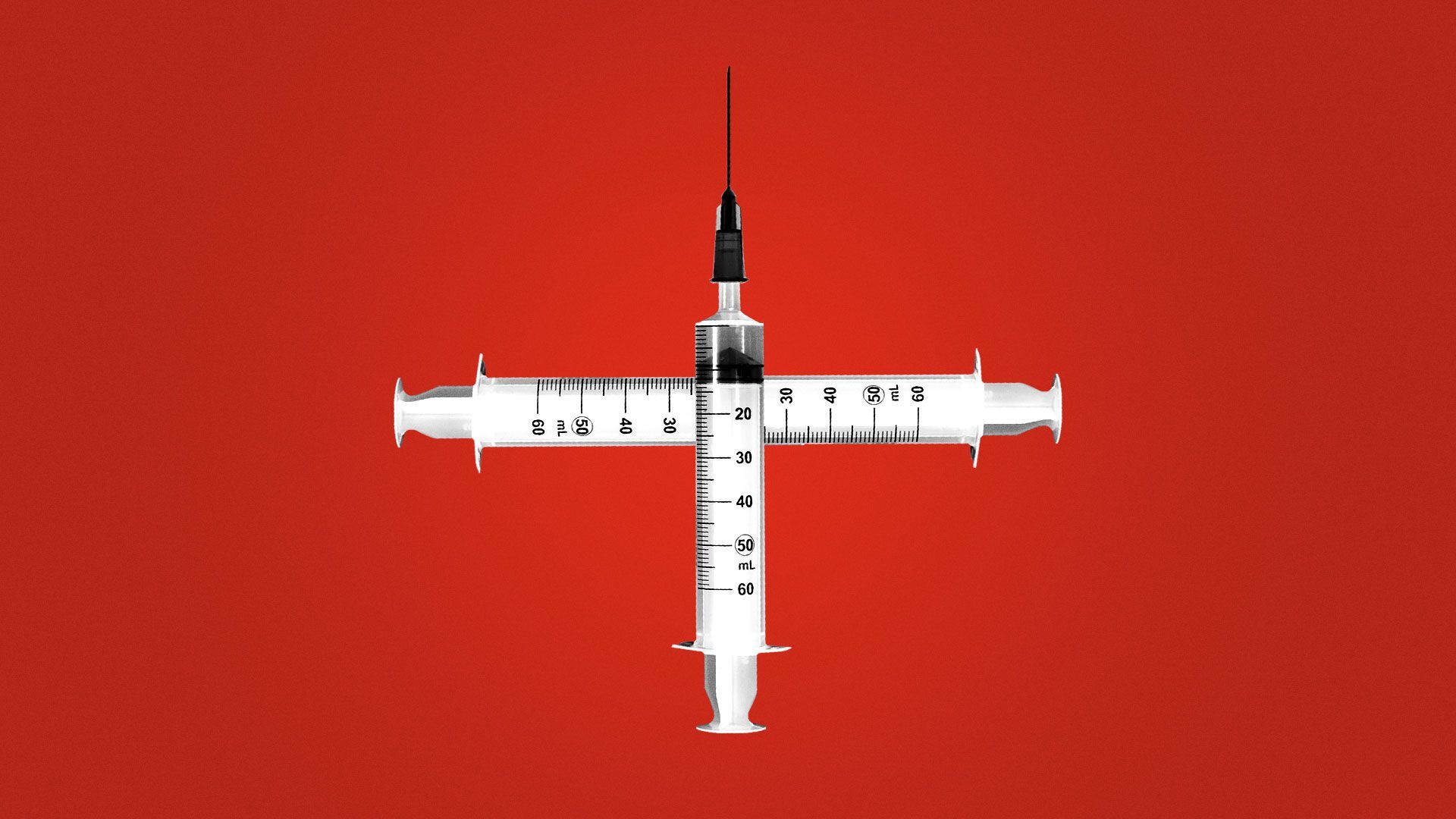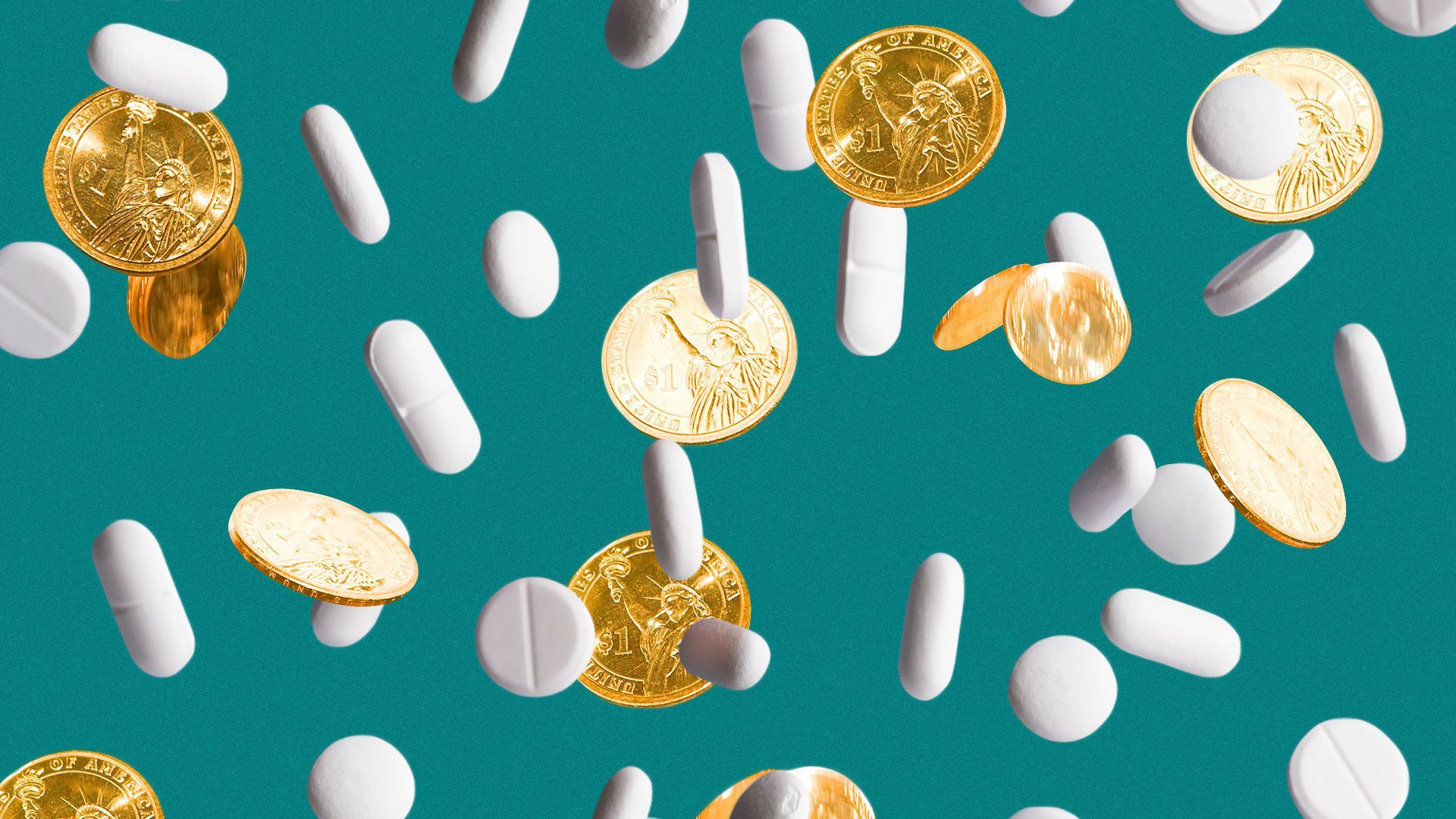| | | | | | | Presented By PhRMA | | | | Axios Vitals | | By Tina Reed ·Nov 04, 2021 | | Good morning, Vitals readers. Today's newsletter is 1,002 words or a 4-minute read. 💻 Join me today at 12:30pm ET for a virtual event on the future of the diagnostic journey for patients with rare diseases. Guests include RARE-X founder and chief engagement officer Nicole Boice and National Center for Advancing Translational Sciences acting director Joni L. Rutter. Register here. Situational awareness: Moderna reports its third-quarter earnings today. | | | | | | 1 big thing: Rural health systems' trouble with vaccine mandates |  | | | Illustration: Eniola Odetunde/Axios | | | | An estimated 40% of U.S. health systems have instituted COVID-19 vaccine mandates, and though many are reporting high compliance, the requirements are exacerbating workforce shortages and threatening operations in others. Why it matters: As a federal deadline requiring health care workers to get vaccinated approaches, some officials warn it could hurt health care delivery at small and rural hospitals. "It's a moment of dread for the vast majority" of rural hospitals, Carrie Cochran-McClain, chief policy officer for the National Rural Health Association, told Axios. - "I don't think I'm being extreme when I'm saying it could mean some facilities will have to close their doors."
Where it stands: Health systems across the country reported only handfuls of workers — often around 1% to 2% of their workforces — chose to leave due to mandates. The bottom line: The pain has not been felt equally, Cochran-McClain said. - Regions of the country where there is more vaccine hesitancy may struggle with losing more workers. Some service lines may be forced to close or limit access, Cochran-McClain said.
- For example, an upstate New York hospital shut down its maternity ward after six workers opted to quit rather than be vaccinated. It was no isolated event, she said.
- "I just spoke to a hospital administrator yesterday and a significant portion of their lab techs chose not to be vaccinated and now they can't provide lab services," Cochran-McClain said.
What they're saying: "It's really important for us that folks understand, at least from our association and our members' perspective, we are very pro-vaccine," she said. "The challenge is, we're applying this to communities that are already facing severe workforce shortages." Related: Vaccine deadlines have arrived for millions of workers |     | | | | | | 2. Employer drug costs on Dems' radar |  | | | Illustration: Annelise Capossela/Axios | | | | The Democrats' drug pricing plan doesn't just apply to Medicare — parts of it also extend into the commercial market, Axios' Caitlin Owens writes. - It would give the federal government an unprecedented new role in regulating prices paid by private insurance.
Why it matters: Medicare negotiations may be the highlight of the plan, but this quieter expansion could signal a political appetite for cost-cutting reforms loathed by most of the health industry. Where it stands: The deal Democrats announced earlier this week caps how much drug companies can raise drug prices in both Medicare and the commercial market, limiting price hikes to inflation. What they're saying: "I can't think of a precedent where the federal government similarly capped health care price increases in the private sector," KFF's Larry Levitt said. - "The precedent for a federal role in capping prices in commercial insurance is a big deal," he added.
Read more. |     | | | | | | 3. COVID cases fall by 20%, deaths down 15% |  Data: New York Times; Cartogram: Will Chase and Kavya Beheraj/Axios New COVID-19 infections fell by about 20% nationwide over the past two weeks, though parts of the West and Midwest are seeing their caseloads tick higher, Axios' Sam Baker, Will Chase and Kavya Beheraj report. By the numbers: The U.S. is now averaging about 70,000 new cases and 1,400 deaths per day. - Alaska still has the biggest outbreak in the country, relative to its population, with an average of 82 new cases per 100,000 residents. Alaska has led the nation in cases per capita for several weeks, though it's improving significantly.
- Colorado, Montana, New Hampshire, North Dakota and Wyoming are all averaging at least 50 daily cases per 100,000 people.
- Several former hotspots now have the lowest rates of new infection in the country. Six states — Connecticut, Florida, Georgia, Hawaii, Louisiana and Mississippi — are all averaging 10 or fewer cases per day.
What we're watching: The authorization of vaccines for kids will help boost the country's overall vaccination rates, at least a little — and more vaccinations should in turn help avoid another wave of severe illness and death like we saw last winter. Share this map. |     | | | | | | A message from PhRMA | | The cost of medicine needs to be predictable and affordable | | |  | | | | A majority of patients said they would prioritize lowering out-of-pocket costs over insurance premiums. In fact, 3 in 10 Americans who have insurance still face a financial barrier to care. Fixing health care means putting patients first. Learn more from the Patient Experience Survey. | | | | | | 4. America's roads are getting deadlier |  Data: U.S. Department of Transportation; Chart: Danielle Alberti/Axios Motor vehicle crash fatalities experienced the largest half-year spike on record in the first six months of 2021, Axios' Bryan Walsh writes. Why it matters: Road deaths are one of the biggest, if most underappreciated, public health threats in the U.S. and the world. - Speeding, distracted driving, and drug and alcohol use all play a role, but tougher automated traffic policing could help reduce the death toll.
By the numbers: An estimated 20,160 people died in motor vehicle accidents through the first half of 2021, according to data released late last week by the National Highway Traffic Safety Administration (NHTSA). - That's the highest total for the first six months of the year since 2006 and about 18% higher than the death toll for the first half of 2020 — the biggest percentage increase for that time period since NHTSA began keeping records in 1975.
What they're saying: "This is a crisis," Transportation Secretary Pete Buttigieg said in a statement after the data was released. "We cannot and should not accept these fatalities as simply a part of everyday life in America." Go deeper. |     | | | | | | 5. U.S. suicide rates decline for some groups |  Suicide deaths dropped overall in the U.S. for the second year in a row by 3%, according to preliminary data out Wednesday from the CDC, Axios' Marisa Fernandez reports. But, but, but: There were increases in suicide among young adults over 35, as well as American Indians and Alaska Natives, Black Americans and Hispanic Americans. - Suicide rates were the highest among American Indians and Alaska Natives, which increased by 5% in 2020, followed by white Americans.
- Black and Hispanic women had the lowest rates of suicide among any group. White women had the largest decline at 10% between 2019 and 2020.
If you or someone you know may be considering suicide, contact the National Suicide Prevention Lifeline at 1-800-273-8255 (En Español: 1-888-628-9454; Deaf and Hard of Hearing: dial 711 then 1-800-273-8255) or the Crisis Text Line by texting HOME to 741741. |     | | | | | | 6. Business notes | - CVS Health beats on earnings and gets lift from COVID vaccines and prescription volumes. (CNBC)
- Humana's Medicare growth helps weather pandemic costs. (Forbes)
- Theranos swiped logos from Pfizer and another pharma giant for fake reports. (Ars Technica)
|     | | | | | | A message from PhRMA | | The cost of medicine needs to be predictable and affordable | | |  | | | | A majority of patients said they would prioritize lowering out-of-pocket costs over insurance premiums. In fact, 3 in 10 Americans who have insurance still face a financial barrier to care. Fixing health care means putting patients first. Learn more from the Patient Experience Survey. | | | | 📫 Did someone share this newsletter with you? Here's where you can subscribe. |  | | It'll help you deliver employee communications more effectively. | | | | | | Axios thanks our partners for supporting our newsletters. If you're interested in advertising, learn more here.
Sponsorship has no influence on editorial content. Axios, 3100 Clarendon Blvd, Suite 1300, Arlington VA 22201 | | | You received this email because you signed up for newsletters from Axios.
Change your preferences or unsubscribe here. | | | Was this email forwarded to you?
Sign up now to get Axios in your inbox. | | | | Follow Axios on social media:    | | | | | |









No comments:
Post a Comment